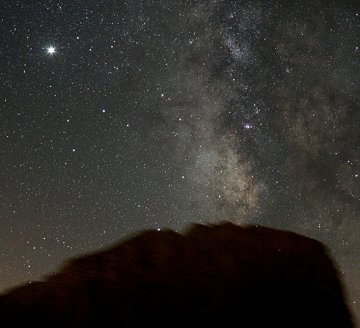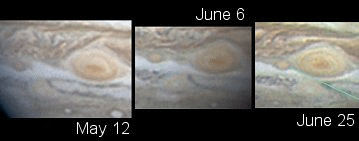| AURORA ALERTS: Did you miss the Northern Lights of June 25th? Next time get a wake-up call from Space Weather PHONE. | | | NOCTILUCENT VERMONT: So far this year, noctilucent clouds have been sighted mainly over Europe, with a smattering over Canada, and none over the USA--make that almost none: "Last night (6 July 2008) while flying from Chicago to Vermont, I observed some noctilucent clouds about 300 miles west of Burlington," reports veteran sky watcher Jan Curtis. "It was a small patch extending 10o to 15o above the horizon. Too bad I couldn't get to my camera!" Readers living in northern-tier US states, it is time to join the hunt for NLCs; observing tips may be found in the photo gallery. SEE JUPITER AT ITS BRIGHTEST: Lately, have you noticed an unusually bright light in the night sky? That would be Jupiter. On Wednesday, July 9th, the king of planets makes its closest approach to Earth for all of 2008, which means now is the time to see Jupiter at its biggest and brightest. No sky map is required; just look southeast after sunset for something like this: 
Photo details: Canon 400D, 300 sec, ISO 1600
Greek amateur astronomer Tilemachos Athanasiadis took the picture on July 5th. It shows Jupiter and the Milky Way shining over the dark form of Mount Olympus, "the throne of Zeus!" he points out. If you have a backyard telescope, point it at Jupiter. Even small department store optics will show you rust-colored cloud belts, Jupiter's four largest moons and, if you happen to look at the right moment, the Great Red Spot, an anti-cyclone twice as wide as Earth. Just a few days ago, the Great Red Spot ran over a cousin, the Little Red Spot, and may have destroyed the smaller storm. Scroll down for details. more images: from Luis Carreira of Castelo de Vide, Portugal; from Jeffrey Berkes of Assateague Island, Maryland; COLLIDING STORMS ON JUPITER: For the past few months, astronomers have been monitoring not one but three red spots on Jupiter: the familiar Great Red Spot plus two younger, smaller upstarts known as Oval BA and the Little Red Spot (LRS). Last week the three storms collided. Amateur astronomer Anthony Wesley of Australia photographed their convergence: 
Click to view full-planet images
On July 1st, with clouds blocking Wesley's view from Australia, the Little Red Spot (1) got squeezed like toothpaste between the Great Red Spot (2) and Oval BA (3). Did the little spot survive? Maybe, maybe not. A July 5th photo by Wesley seems to show only two storms emerging from the clash. But a July 7th photo taken by Christopher Go of the Philippines suggests "the LRS survived the gauntlet" and may be reforming. Survival wouldn't be a surprise. Even a "little" storm on Jupiter is huge. The LRS is about the size of Mars and may be able to withstand considerable abuse from its larger siblings. The monitoring continues; stay tuned for updates.
2008 Aurora Gallery
[Aurora Alerts] [Night-sky Cameras] | 
